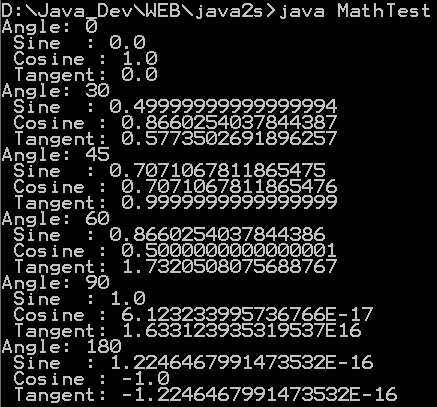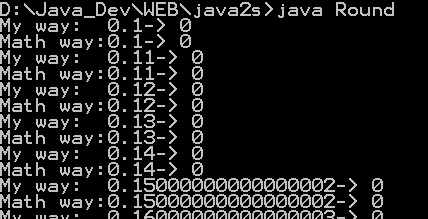Complex Number Demo
/*
3.0+5.0i
3.0+5.0i.getReal() = 3.0
3.0+5.0i + 2.0-2.0i = 5.0+3.0i
3.0+5.0i + 2.0-2.0i = 5.0+3.0i
3.0+5.0i * 2.0-2.0i = 16.0+4.0i
-0.5+2.0i
*/
/** A class to test Complex Numbers.
* @author Ian F. Darwin, http://www.darwinsys.com/
* @version $Id: ComplexDemo.java,v 1.6 2004/05/13 22:28:59 ian Exp $
*/
public class ComplexDemo {
/** The program */
public static void main(String[] args) {
Complex c = new Complex(3, 5);
Complex d = new Complex(2, -2);
System.out.println(c);
System.out.println(c + ".getReal() = " + c.getReal());
System.out.println(c + " + " + d + " = " + c.add(d));
System.out.println(c + " + " + d + " = " + Complex.add(c, d));
System.out.println(c + " * " + d + " = " + c.multiply(d));
System.out.println(Complex.divide(c, d));
}
}
/** A class to represent Complex Numbers. A Complex object is
* immutable once created; the add, subtract and multiply routines
* return newly-created Complex objects containing the results.
*
* @author Ian F. Darwin, inspired by David Flanagan.
* @version $Id: Complex.java,v 1.3 2004/05/13 22:28:59 ian Exp $
*/
class Complex {
/** The real part */
private double r;
/** The imaginary part */
private double i;
/** Construct a Complex */
Complex(double rr, double ii) {
r = rr;
i = ii;
}
/** Display the current Complex as a String, for use in
* println() and elsewhere.
*/
public String toString() {
StringBuffer sb = new StringBuffer().append(r);
if (i>0)
sb.append('+'); // else append(i) appends - sign
return sb.append(i).append('i').toString();
}
/** Return just the Real part */
public double getReal() {
return r;
}
/** Return just the Real part */
public double getImaginary() {
return i;
}
/** Return the magnitude of a complex number */
public double magnitude() {
return Math.sqrt(r*r + i*i);
}
/** Add another Complex to this one
*/
public Complex add(Complex other) {
return add(this, other);
}
/** Add two Complexes
*/
public static Complex add(Complex c1, Complex c2) {
return new Complex(c1.r+c2.r, c1.i+c2.i);
}
/** Subtract another Complex from this one
*/
public Complex subtract(Complex other) {
return subtract(this, other);
}
/** Subtract two Complexes
*/
public static Complex subtract(Complex c1, Complex c2) {
return new Complex(c1.r-c2.r, c1.i-c2.i);
}
/** Multiply this Complex times another one
*/
public Complex multiply(Complex other) {
return multiply(this, other);
}
/** Multiply two Complexes
*/
public static Complex multiply(Complex c1, Complex c2) {
return new Complex(c1.r*c2.r - c1.i*c2.i, c1.r*c2.i + c1.i*c2.r);
}
/** Divide c1 by c2.
* @author Gisbert Selke.
*/
public static Complex divide(Complex c1, Complex c2) {
return new Complex(
(c1.r*c2.r+c1.i*c2.i)/(c2.r*c2.r+c2.i*c2.i),
(c1.i*c2.r-c1.r*c2.i)/(c2.r*c2.r+c2.i*c2.i));
}
/* Compare this Complex number with another
*/
public boolean equals(Object o) {
if (!(o instanceof Complex))
throw new IllegalArgumentException(
"Complex.equals argument must be a Complex");
Complex other = (Complex)o;
return r == other.r && i == other.i;
}
/* Generate a hashCode; not sure how well distributed these are.
*/
public int hashCode() {
return (int)( r) | (int)i;
}
}
Related examples in the same category
| 1. | Absolute value | | |
| 2. | Find absolute value of float, int, double and long using Math.abs | | |
| 3. | Find ceiling value of a number using Math.ceil | | |
| 4. | Find exponential value of a number using Math.exp | | |
| 5. | Find floor value of a number using Math.floor | | |
| 6. | Find minimum of two numbers using Math.min | | |
| 7. | Find power using Math.pow | | |
| 8. | Find square root of a number using Math.sqrt | | |
| 9. | Find natural logarithm value of a number using Math.log | | |
| 10. | Find maximum of two numbers using Math.max | | |
| 11. | Get the power value | |  |
| 12. | Using the Math Trig Methods | |  |
| 13. | Using BigDecimal for Precision | |  |
| 14. | Demonstrate our own version round() | |  |
| 15. | Demonstrate a few of the Math functions for Trigonometry | |  |
| 16. | Exponential Demo | |  |
| 17. | Min Demo | | |
| 18. | Basic Math Demo | |  |
| 19. | Using strict math in applications | |  |
| 20. | Conversion between polar and rectangular coordinates | | |
| 21. | Using the pow() function | | |
| 22. | Using strict math at the method level | | |
| 23. | Calculating hyperbolic functions | | |
| 24. | Calculating trigonometric functions | | |
| 25. | Weighted floating-point comparisons | | |
| 26. | Solving right triangles | | |
| 27. | Applying the quadratic formula | | |
| 28. | Calculate the floor of the log, base 2 | | |
| 29. | Greatest Common Divisor (GCD) of positive integer numbers | | |
| 30. | Least Common Multiple (LCM) of two strictly positive integer numbers | | |
| 31. | Moving Average | | |
| 32. | Make Exponention | | |
| 33. | Caclulate the factorial of N | | |
| 34. | Trigonometric Demo | |  |
| 35. | sqrt(a^2 + b^2) without under/overflow | | |
| 36. | Returns an integer hash code representing the given double array value. | | |
| 37. | Returns an integer hash code representing the given double value. | | |
| 38. | Returns n!. Shorthand for n Factorial, the product of the numbers 1,...,n as a double. | | |
| 39. | Returns n!. Shorthand for n Factorial, the product of the numbers 1,...,n. | | |
| 40. | Returns the hyperbolic sine of x. | | |
| 41. | Contains static definition for matrix math methods. | | |
| 42. | For a double precision value x, this method returns +1.0 if x >= 0 and -1.0 if x < 0. Returns NaN if x is NaN. | | |
| 43. | For a float value x, this method returns +1.0F if x >= 0 and -1.0F if x < 0. Returns NaN if x is NaN. | | |
| 44. | Normalize an angle in a 2&pi wide interval around a center value. | | |
| 45. | Normalizes an angle to a relative angle. | | |
| 46. | Normalizes an angle to an absolute angle | | |
| 47. | Normalizes an angle to be near an absolute angle | | |
| 48. | Returns the natural logarithm of n!. | | |
| 49. | Returns the least common multiple between two integer values. | | |
| 50. | Gets the greatest common divisor of the absolute value of two numbers | | |
| 51. | Matrix manipulation | | |
| 52. | Returns exact (http://mathworld.wolfram.com/BinomialCoefficient.html) Binomial Coefficient | | |
| 53. | Returns a double representation of the (http://mathworld.wolfram.com/BinomialCoefficient.html) Binomial Coefficient | | |
| 54. | Returns the natural log of the (http://mathworld.wolfram.com/BinomialCoefficient.html) Binomial Coefficient | | |
| 55. | Returns the hyperbolic cosine of x. | | |
| 56. | Math Utils | | |
| 57. | Implements the methods which are in the standard J2SE's Math class, but are not in in J2ME's. | | |
| 58. | Utility methods for mathematical problems. | | |
| 59. | A math utility class with static methods. | | |
| 60. | Computes the binomial coefficient "n over k" | | |
| 61. | Log Gamma | | |
| 62. | Log Beta | | |
| 63. | Beta | | |
| 64. | Gamma | | |
| 65. | Factorial | | |
| 66. | Computes p(x;n,p) where x~B(n,p) | | |
| 67. | Returns the sum of two doubles expressed in log space | | |
| 68. | sigmod | | |
| 69. | sigmod rev | | |
| 70. | Numbers that are closer than this are considered equal | | |
| 71. | Returns the KL divergence, K(p1 || p2). | | |
| 72. | Returns the sum of two doubles expressed in log space | | |
| 73. | Returns the difference of two doubles expressed in log space | | |
| 74. | Is Prime | | |
| 75. | Statistical functions on arrays of numbers, namely, the mean, variance, standard deviation, covariance, min and max | | |
| 76. | This class calculates the Factorial of a numbers passed into the program through command line arguments. | |  |
| 77. | Calculates the Greatest Common Divisor of two numbers passed into the program through command line arguments. | | |
| 78. | Variance: the square of the standard deviation. | | |
| 79. | Population Standard Deviation | | |
| 80. | Returns from a static prime table the least prime that is greater than or equal to a specified value. | | |